New York City Ballet opens its fall season (September 20 to October 16) with four new ballets.
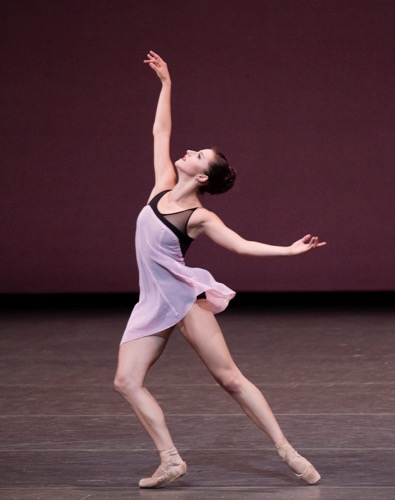
New York City Ballet’s Indiana Woodward in Lauren Lovette’s For Clara. Photo: Paul Kolnik
The New York City Ballet’s gala performances are intriguing phenomena—so many gowns trailing hazardous trains during the pre-performance cocktail party on the second floor promenade, so many tiny, slightly slippery hors d’oeuvres, and at the same time such pride and good spirits among those helping to fund one of New York City’s two major ballet companies.
Actually, the number of trains seemed down at the gala that opened New York City Ballet’s 2016 fall season on Tuesday, September 20— the fifth to involve collaborations between choreographers and fashion designers, not to mention ones among designers and audience members. Outfits by Rosie Assoulin, Narciso Rodriguez, Jason Wu, and Dries Van Noten also sent secret messages from stage to theater seats. Each new ballet was preceded by a brief film showing rehearsals as well as costume-shop activities: dancers checking garments for mobility, choreographers and designers conversing and making statements to the camera. Director of Costumes, Marc Happel adroitly mediates, delivers reassuring words, and refrains from caustic comment.
Four of the five choreographers participated, at one time or another, in the workshops of NYCB’s affiliate, the New York Choreographic Institute. But they differ in terms of experience. Annabelle Lopez Ochoa has since created works for numerous ballet companies here and abroad. Justin Peck, still performing in NYCB as a soloist, is also a prolific resident choreographer for it and other ensembles. This gala also marks the professional choreographic debut of Lauren Lovette (a principal dancer with the company) and Peter Walker (a member of its corps de ballet). The final work of the evening, an excerpt from Bal de Couture by Ballet Master in Chief Peter Martins with attire by Valentino, appeared on the first mating of the two disciplines in 2012.
One of the pleasures of attending NYCB premieres is watching the dancers’ response to new challenges, and the ways in which guest choreographers or fledgling choreographers in the company respond to them. Always beautiful, sleek, and expert in the repertory’s treasury of ballets by George Balanchine, Jerome Robbins, and Martins, when new ballets premiere, they seem to acquire extra polish, extra zest—as excited as race horses at the starting gate.
On this particular occasion, some of the choreographers too occasionally seem have gotten carried away and piled effect on effect. Sometimes they had lapses in invention, but never were the works simplistic or dull-witted.
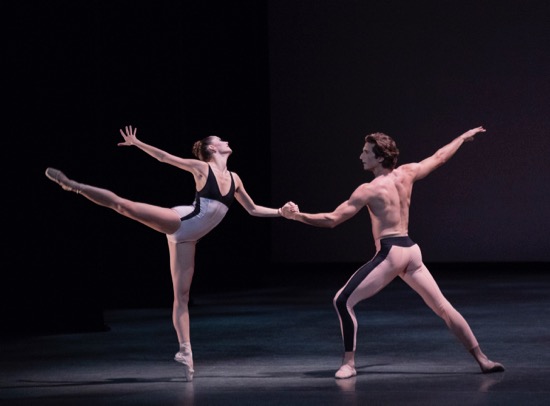
Unity Phelan and Zachary Catazaro in Lauren Lovette’s For Clara. Photo: Paul Kolnik
Lovette chose to set her ballet to Robert Schumann’s Introduction and Concert-Allegro, op. 134, and, knowing that it was his gift to his pianist-wife on her 34th birthday, titled it For Clara. NYCB pianist Susan Walters played the solo instrument, while Clotilde Otranto conducted.
The ballet’s beginning and ending hints at an emotional journey of some sort. The opening image is of a man (Chase Finlay), isolated in a follow spot, reaching his rippling arms out into the darkness, as troubled as he is supple. The last is of a woman (it is Emily Gerrity) coming downstage to face us and lift her arms in triumph. In between these events, Lovette devises interactions among her principal dancers (Gerrity, Zachary Catazaro, Unity Phelan, Indiana Woodward, and Chase Finlay) and black-clad cadres of six men and six women.
I’m impressed by the fluent, often complex use that Lovette makes of structural devices—having a movement, say, travel down a line of women like an infection, or humanizing her corps by having a group of men standing at ease to watch Woodward and her female friends dance. At one point, she builds a pattern by having dancers enter individually to swell an already established passage for couples. And one effective transition has the crowd in black backing offstage as Gerrity, lifted by male hands, approaches them (too often in ballets, people rush offstage for no discernible reason, except to clear the space for others).
The two pas de deux in For Clara are well-made and excellently performed, but I prefer the gentler one for Finlay and Woodward to the one for Catazaro and Phelan, perhaps because the latter encounter involves a lot of manhandling (push, pull, lift, drag) of the woman by her partner—a familiar ballet trope that, to me, is more acceptable in depictions of dramatic violence or traditional acrobatics. And you wonder, does Phelan lack the little skirt that her two colleagues’ costumes have simply because it would get in the way of, or obscure, the vigorous partnering?
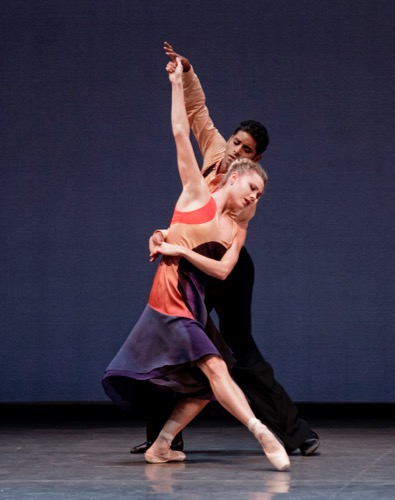
Sara Mearns and Amar Ramasar in Justin Peck’s The Dreamers.
Photo: Paul Kolnik
Peck’s The Dreamers, a pas de deux for Sara Mearns and Amar Ramasar, is more egalitarian, even as it honors the man’s role as one who supports the woman. Set to the Adagio from Bohuslav Martinu’s Piano Quintet No. 2, the lovely duet indeed at times suggests a dream. In the beginning, the two dancers simply walk together in silence, and later they walk again, and for a long time. Once, Mearns just stands still, almost lost in thought, while Ramasar dances around her. For a short while, he lies on his back, motionless, while she dances, (his dream?). They also lie down for a while, head to head (do lovers think they can transfer thoughts this way?). But in the end, after they’ve repeated their opening, they lie side by side, and in the last few seconds of the Dreamers, he rolls over to lay his body over hers.
Part of what’s fine about this small, brief work is the way these superb dancers execute Peck’s finely designed movements. They touch one another gravely and considerately, but without fanfare as if asking, “Are you sure you want to do this with me?” And the answer is “yes.”
Van Noten’s costumes for Peck’s work were inspired in part by Mark Rothko’s paintings. Handsome as works of art, they are, however, distracting as costumes. Mearns’s simply cut dress is boldly patterned on one side and black on most of the other, which means that she becomes a different person, depending on which way she’s facing. Amasar’s outfit looks as if pieces suggesting suspenders, belt, and necktie have been sewn to his shirt in various unlikely places.
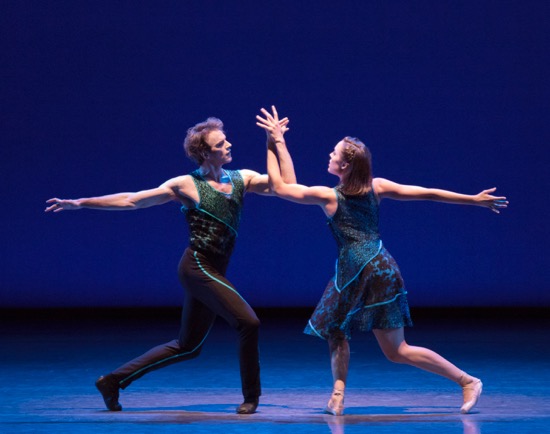
Russell Janzen and Emily Kikta in Peter Walker’s ten in seven. Photo: Paul Kolnik
The stage acquires a very different look for Walker’s ten in seven. Composer-guitarist Thomas Kikta; guest keyboard player, Arkadiy Figlin; and NYCB Orchestra’s Raymond Mase (trumpet) and James Saporito (percussion) are on high scaffolding that extends from stage left in an “L” along the back for a short distance. Toward the end, while Spartak Hoxha dances alone in light patterns projected onto the floor, the others cluster near the base of the structure, leaning on it or hanging off it.
Walker uses space in very interesting ways in his seven-section ballet, although sometimes I find myself wishing that he’d let his lively phrases of dancing breathe a bit more. The dancers wear Wu’s attractive costumes, with black lace and/or net laid over a color, and the piece is accompanied by selections with such titles as “Divertissement du Blues” and Mélodie Majestueuse.” Hoxha performs his solo to the aptly titled “Rapide Furieux,” while Figlin attacks the keyboard. Walker gives all the dancers moments in the limelight; ten dancers = three duets, one trio, and a solo. Four women enhance Gretchen Smith and Daniel Applebaum’s moment together; four men mingle with Sean Suozzi as he entertains Woodward. Emily Kikta (the composer’s daughter) and Russell Janzen have the stage to themselves. The mood throughout is upbeat, jazzy here and there, the balletic feats playfully competitive. I especially enjoyed the trio for Taylor Stanley, Ashly Isaacs, and Rachel Hutsell. And yes, the pleasure of seeing the keen-witted, sharp-footed Suozzi onstage again.
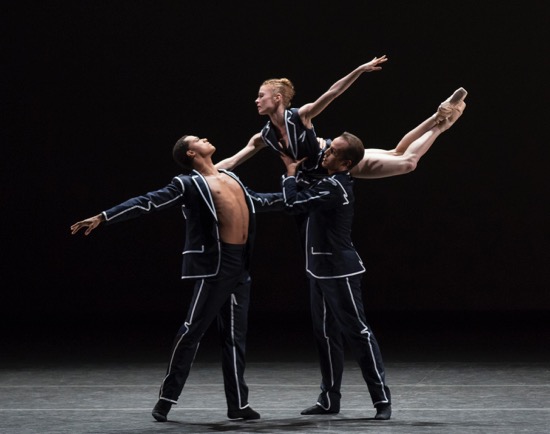
Jared Angle (L), Lauren King, and Preston Chamblee in Annabelle Lopez Ochoa’s Unframed. Photo: Paul Kolnik
Lopez Ochoa’s Unframed ended up with, to my mind, the most compelling costumes of the evening, in terms of suiting the choreography. Assoulin’s black jackets with white piping worn over black trunks with white waistbands may have been meant to suggest the corporate world, but it also makes you think of carryings-on in a permissive prep-school, and the tops can be removed or put back on (with some of the disrobing done onstage). Mark Stanley, who imaginatively lit all five ballets on the program, provided a fluorescent tube hanging horizonallty, a vertical one, and a right-angled one close to the floor on one side.
The music for Lopez Ochoa’s ballet is startlingly eclectic: two sections from Luigi Boccherini’s Quintet in D major, two from Edward Elgar’s Cello Concerto in E Minor, one from Antonio Vivaldi’s Cello Concerto in A Minor, and Pēteris Vasks’ Grãmata čellam (The Book) for Solo Cello: I Dolcissimo. Daniel Capps conducted the orchestra, and cellist Sara Sant’Ambrogio played her instrument from a platform in the pit, at times adding a high, thin vocal line to Vasks’ eerie music.
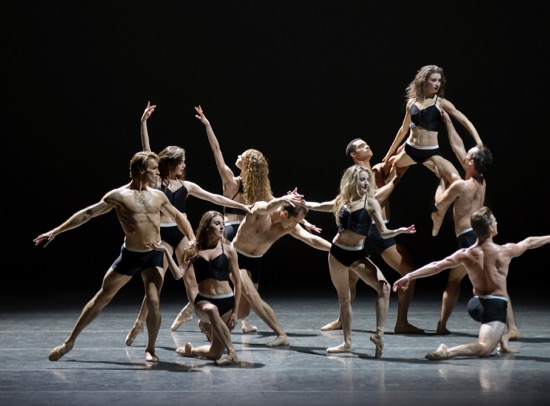
The cast of Annabelle Lopez Ochoa’s Unframed. Photo: Paul Kolnik
It’s to Boccherini that the ten-member cast assembles in a fluctuating clump, lifting the marvelous Tiler Peck, regrouping, lifting others of the women. It’s to Vask’s cello music that the equally splendid Tyler Angle carries her around. And, interestingly, these two sit side by side at the back of the stage, facing away from us, while Lauren King, Jared Angle, and Preston Chamblee tangle, and Sant’Ambrogio begins to wail softly. Then the orchestra wakes up, the dancers put their jackets on, and Boccherini returns us briefly to post-Baroque politesse, before we time-travel to the first of the Elgar selections. Only Alexa Maxwell (replacing Brittany Pollack), Daniel Ulbrecht, and both Angle brothers remain onstage, joined by two four-woman squads. Ulbricht get to show off—jauntily and with ease—his amazing ability to soar.
Sterling Hyltin and Adrian Danchig Waring have the stage to themselves while they dance to the Adagio from Elgar’s beautiful concerto. Her abundance of long, wavy hair hangs loose (in Balanchine country, that has always signified dream or myth or abandon), and foams around the two as they move slowly through impassioned embraces and ecstatically expansive movements on Hyltin’s part. When the other women re-enter, they too have let down their hair. Vivaldi wakes everyone up to speed and a degree of formality. Even so, it’s Hyltin and Danchig Waring who have the final moment, except that the vertical fluorescent tube decides to have the very last word and rises straight upward.
Lopez Ochoa is a gifted choreographer, and vivid moments and images course through Unframed. However, the title seems to excuse it from presenting a single viewpoint, so it comes across as a string of unrelated acts that have been craftily made to seem to belong together. I keep wanting to say, “Wait, what. . .?” And “what determines jacket-removal”? “And where are we anyway?” The dancers—all praise to them—look determinedly at home, as if they think they know the answer to this last question.
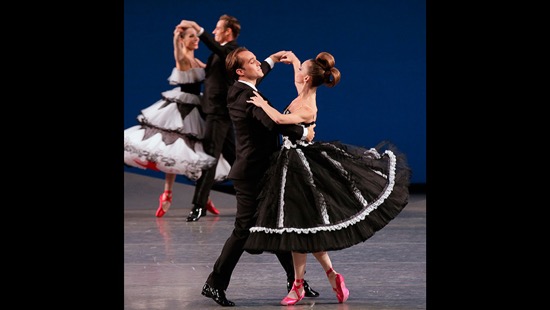
Peter Martins’s Bal de Couture in 2012. Foreground: Jared Angle and Maria Kowroski. Photo: Paul Kolnik
And then, to end the show: Martins’s 2012 Bal de Couture. Six couples—the women in gorgeous bouffant Valentino dresses—waltz and waltz in circles and in mirror-image symmetry, while three other pairs—the women in tutus— do more elaborate things (unfortunately undermined by the red pointe shoes that draw too much attention to their feet). The music for the excerpt comes from Act II of Tchaikvsky’s Eugen Onegin. The ballet showcases eighteen dancers who, with one exception (Alexa Maxwell), haven’t yet appeared tonight. Bal de Couture also functions as a grand lead-in to the dinner that awaits the happy patrons in the lobby.
These ballet lovers may be hungry, but their appetite for splendid performing ought to be temporarily quenched. In that sense, they come to the flower-decked tables brim-full.
Note: The new ballets can be seen again on September 27, October 1 (eve), 5, and 15 (mat).

The white piping on the costumes for Ochoa’s work remind me of tailor’s chalk, marking where adjustments need to be made. I cannot tell, though, from your narration of the ballet, if this might be another way in to the choreography, or just a sidelight.
Dear Deborah! I really enjoyed your review. My personal favorite moment was:” Hoxha performs his solo to the aptly titled “Rapide Furieux,” while Figini attacks the keyboard.” I never have seen “Mr.Figini” do that because I was at the keyboard pretty much all the time. I would appreciate if you will take this information into consideration. Respectively yours, “ten in seven”‘s guest keyboard player Arkadiy Figlin.
The elusive pianist, “Figini,” has vanished from my review, having ceded credit for the attack on the keyboard to the musician responsible for said attack.